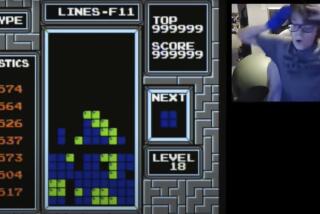‘Spy Hunter’ Back on the Road
- Share via
Oh, to be 15 again--still without a driver’s license, a steady girlfriend or even much of a clue. Thank heaven for coin-op arcade games such as “Spy Hunter,” which gave awkward and misunderstood teens of the early 1980s a chance to taste the dashing, daring life ahead.
Sorta.
Midway’s “Spy Hunter” was sweet for its day, a simple top-down driving simulator that put players behind the wheel of a souped-up secret agent ride packing all kinds of high-tech heat. In many ways, modern three-dimensional vehicular combat games such as “Twisted Metal” andor “Vigilante 8” are the illegitimate descendants of “Spy Hunter.”
But now the rightful, pure-blooded heir to the “Spy Hunter” legacy has debuted on Sony PlayStation 2. plainly named .The new “Spy Hunter” remains true to the spirit of the original, but adds considerable depth and flash. It’s equally thrilling and maddening--a game that seems .unable .to can’t decide whether it wants to be a home console title with hours of replay value or a quarter-gobbling arcade machine that stresses repetition.
At its core, the soul of “Spy Hunter” remains unchanged, revealing relying on the timeless and universal appeal of fast cars with big guns. Players slip into the G-6155 Interceptor, a sports car outfitted with machine guns, guided missiles, smoke screens and the ability to morph into a speedboat or motorcycle. Once ensconced in this testament to technology, drivers proceed to settle the world’s problems through superior firepower.
Unlike the original--in which players drove along an endless stretch of unchanging pavement--the PS2 version winds through exotic and exquisitely detailed locales such as Venice in search of Daemon Curry, the evil head of Nostra International, a multinational company with aspirations of world domination.
Rather than employing espionage and subtlety, though, “Spy Hunter” is all bang and flash, a direct frontal assault on Nostra that more dependent relies on quick reflexes more than quick wits. There is no pdilemma roblem tthat cannot be solved by smashing into it, blowing it up or riddling it with bullet holes.
That’s both a strength and a weakness. Novices can pick up the game and get rolling instantly. The first level exposes players to all the basic elements of the game. They blast targets with machine guns, attach trackers to renegade boats and activate satellite transmitters as they switch from car to boat to motorcycle and back to car.
Sadly, many players won’t advance much beyond the first level or two. That’s because “Spy Hunter” relies too heavily on its coin-op past. In coin-op games, the object is to separate arcade customers with from as much money as possible as quickly as possible. So the learning curve is steep, rigid and unforgiving, forcing players to cover the same ground over and over until they get it right and can move on.
On the PS2, “Spy Hunter” carries on this tradition with progressively harder missions, each with its own set of objectives. Usually, only one or two must be completed to fulfill a mission. But players get extra points if they achieve the optional goals.
It turns out, however, that those “optional” goals are not so optional. Players need the points to advance to higher levels. So unless they flawlessly achieve every objective in a given level, players have to replay and replay and replay until they cobble together enough points to unlock the next mission. This wouldn’t be so onerous if the levels featured truly random enemy activity. Instead, players end up feeling like Bill Murray in “Groundhog Day” as they relive the same events.
Video games built for the home aren’t supposed to be that rigid. Spending $50 on a game should entitle owners to decide what kind of experience they want. That’s the rationale behind difficulty settings and games with variable endings. “Spy Hunter” offers none of that choice. It’s either the “Spy Hunter’s” way or the highway.
Players nostalgic for the game they remember from their youth should Rrent “Spy Hunter” for the weekend and then track down some cheat codes so they can to play their your way. I don’t totally understand this: if they’re nostalgic then wouldn’t they WANT it to play like the arcade?
*
“Tetris Worlds”: There are relatively few certainties in this world. One of them is that every new hand-held game machine from Nintendo will usher in at least one new version of “Tetris,” the addictive puzzle block game that first appeared in 1987. For Game Boy Advance, that’s “Tetris Worlds,” a bundle of six “Tetris” variations.
Except for absolute die-hard “Tetris” fans, there’s no reason to buy “Tetris Worlds.” Since old Game Boy and Game Boy Color cartridges work in Game Boy Advance, players should just pick up any of the various “Tetris” games they probably already have floating around.
“Tetris Worlds” offers some snappy background graphics, but otherwise adds little to the classic game, whose simplicity is the key to its popularity. The variations are interesting, but none are as elegant or as simple as the original.
*
Aaron Curtiss is editor of Tech Times. He can be reached at aaron.curtiss@latimes.com.
(BEGIN TEXT OF INFOBOX / INFOGRAPHIC)
The Skinny
“Spy Hunter”
* Genre: Vehicle combat
* Platform: Sony PlayStation 2
* Price: $50
* Publisher: Midway
* ESRB* rating: Teen
* The good: Slick graphics, fierce action
* The bad: Rigid game play
* Bottom line: A fine rental
“Tetris Worlds”
* Genre: Puzzler
* Platform: Game Boy Advance
* Price: $40
* Publisher: THQ
* ESRB rating: Everyone
* The good: Classic “Tetris” with new versions
* The bad: Not much new
* Bottom line: Current “Tetris” owners need not bother
*
* Entertainment Software Ratings Board
More to Read
The biggest entertainment stories
Get our big stories about Hollywood, film, television, music, arts, culture and more right in your inbox as soon as they publish.
You may occasionally receive promotional content from the Los Angeles Times.










